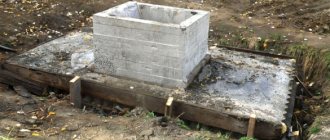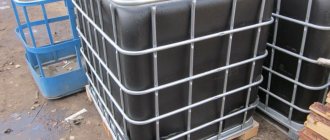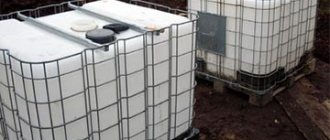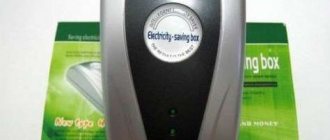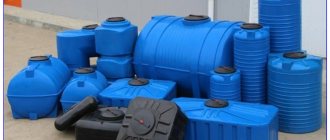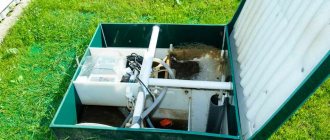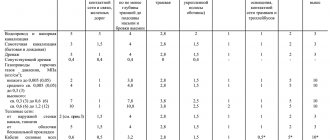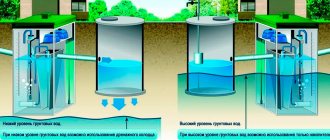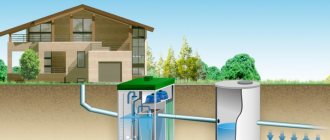One of the latest technologies of the Russian manufacturer among the designs of treatment facilities is the Bars septic tank. This is a scientific development of domestic professors at MGSU.
That is why the BARS treatment equipment has proven to be the most durable, powerful and most reliable sewer installation.
Its adaptation to the conditions of any Russian area, moderate cost and high degree of purification are the qualities that distinguish the Bars septic tank from fakes or any analogues.
In order to choose the right septic tank model, have a more complete understanding of all modifications of the septic tank, its technical details and capabilities, as well as understand the operating principle of its internal devices, it is necessary to carefully study all its characteristics.
How is wastewater treated?
Wastewater through the supply pipeline (1) enters the first chamber of the septic tank, where suspended particles settle and fatty particles float to the surface.
Next, the wastewater previously purified in this way passes through the biofilter (2) into the second chamber of the septic tank. The biofilter accumulates anaerobic bacteria on its surface, which purify wastewater from organic contaminants. In the second chamber, suspended particles are separated that were not retained in the first chamber of the septic tank. From the second chamber, through an inclined pipe (3), the wastewater enters the biofilter (4), located in the third chamber of the septic tank. The inclined pipe reduces the turbulence of the flow, which leads to a smooth deposition of contaminants on the biofilter (4). In the third chamber, further separation of suspended substances occurs that were not retained in the previous purification stages. From the third chamber, through the outlet pipeline (5), the treated wastewater leaves the septic tank and is sent to soil filtration facilities. The BARS-Bio Plus model provides for the installation of a pump for forced drainage of wastewater.
The lineup
Bars installations are represented by products of various types of systems with a wide range of performance.
Bars-N
Bars-N units have a cylindrical, horizontally located body with spherical end walls. The neck is integral with the body. The thickness of the case walls, regardless of volume, is 25 mm.
This installation, in fact, is not a septic tank, since it only serves as a container for collecting wastewater. It is used most often in summer cottages, where people live only periodically.
Note! The buyer has the opportunity to choose a septic tank with different neck heights. The height selection step is 10 centimeters.
Bars-N is equipped with a filling alarm system. The float sensor can be adjusted to any level. The alarm light can be installed indoors.
Storage septic tank Bars-N
Operating principle of the Bars-N septic tank:
- the waste flows by gravity into the storage tank through the inlet pipe;
- when the container is filled to the set level, the indicator light lights up;
- the contents are pumped out using a sewer truck.
Arrangement and connection diagram
Technical characteristics of models of different capacities of the Bars-N storage device are given in the table.
| Septic tank model Bars-N | Volume, l | Hull length, m | Case diameter, m | Weight, kg |
| 2 | 2000 | 2.1 | 1.25 | 120 |
| 3 | 3000 | 3 | 1.25 | 160 |
| 4 | 4000 | 3.9 | 1.25 | 200 |
| 5 | 5000 | 2.9 | 1.55 | 270 |
| 6 | 6000 | 3.4 | 1.55 | 300 |
| 7 | 7000 | 4 | 1.55 | 340 |
| 8 | 8000 | 4.6 | 1.55 | 380 |
| 9 | 9000 | 5.1 | 1.55 | 410 |
| 10 | 10000 | 5.7 | 1.55 | 440 |
| 11 and above | 11000 and above | Selected individually | 1.55 |
Installation work is carried out in the sequence shown in the figure.
Scheme for self-installation of the Bars-N septic tank
Bars-Bio
The Bars-Bio septic tank can be installed in areas with low groundwater levels.
It is a horizontally located container with three chambers separated by biofilters. The design has two solid necks. The height of the necks is selected individually. The wall thickness is 25 mm, the end parts are spherical.
Unlike a storage tank, the wastewater in the installation is purified using aerobic bacteria. The degree of wastewater purification at the outlet is insufficient for water reuse (for example, for irrigation). Therefore, simultaneously with the installation of a septic tank, it is mandatory to carry out additional soil treatment. The manufacturer claims that with the correct selection of device power, the need for pumping arises only after 2-3 years of operation.
Three-chamber septic tank Bars-Bio
Wastewater treatment occurs as follows:
- sewage flows through pipe 1 into the middle chamber;
- the contents of the chamber settle, solid particles settle at the bottom;
- the liquid through biofilter 2, powered by the activity of anaerobic bacteria, flows into the second (in the figure on the left) chamber;
- a similar process occurs when liquid passes from the second (on the left) to the third (in the figure on the left) chamber, the movement of water through the middle chamber occurs along an inclined pipe;
- From the last chamber, through pipe 5, the purified liquid flows to soil post-treatment.
Installation diagram
Note! For areas with high groundwater, the manufacturer offers the Bars-Bio Plus installation, equipped with a pump for forced drainage.
Arrangement and connection diagram
Technical characteristics of Bars-Bio units of various capacities can be viewed in the table.
| Bars-Bio model | Water consumption, l/day | Number of permanent residents, persons | Volume, l | Container diameter, m | Tank length, m | Weight, kg |
| 5 | 700-800 | 5 | 2500 | 1.25 | 2.5 | 120 |
| 7 | 900-1000 | 7 | 2850 | 1.25 | 2.8 | 160 |
| 8 | 1000-1100 | 8 | 3400 | 1.25 | 3.3 | 200 |
| 9 | 1100-1300 | 9 | 3950 | 1.25 | 3.8 | 245 |
| 10 | 1300-1500 | 10 | 4550 | 1.25 | 4.3 | 265 |
The installation diagram of the Bars-Bio installation is shown in the figure.
Scheme for self-installation of the Bars-Bio installation
Bars-Mini
This is the lowest power installation. Its design is similar to the Bars-Bio septic tank, however, it is characterized by small dimensions, and the ends of this model are not convex.
Modification Bars-Mini
Bars-Mini is available in three versions, the technical characteristics of which are presented in the table.
| Productivity, l/day | Volume, l | Diameter, m | Length, m | Weight |
| 330 | 1000 | 0.955 | 1.3 | 85 |
| 430 | 1300 | 0.955 | 1.4 | 95 |
| 530 | 1600 | 0.955 | 1.6 | 105 |
Bars-Ultra
The autonomous biological treatment station Bars-Ultra is a horizontally located container with two necks. Can be installed in areas with abundant groundwater and even in wetlands. The thickness of the installation walls is 25 mm.
The installation is equipped with a Japanese Hiblow compressor. The compressor is located outside the station housing, which allows it to be protected from high humidity. Models with the “Plus” prefix are equipped with an additional chamber and a Wilo pump (Germany) for forced removal of liquid.
This is a wastewater treatment system that produces 95-98% purified water at the output. The cleaning process consists of several steps. The installation requires electricity to operate.
Operating principle of the Bars-Ultra septic tank:
- through pipe 1, the wastewater enters the chamber where primary oxidation and sedimentation of large particles occurs;
- through the overflow partition, the liquid enters the compartment with a module containing anaerobic bacteria (the vital activity of the organisms is supported by a fine-bubble aeration system);
- further, the liquid flows into the settling chamber, with a thin-layer block 6 located in it for final clarification of the liquid;
- The activated sludge separated from the water is pumped back into the first chamber, the excess goes into a container for disposal.
Installation diagram
Arrangement and connection diagram
Technical characteristics of models of different power are given in the table.
| Model Bars-Ultra | Water consumption, l/day | Number of people | Electric energy consumption, W/h | Length, m | Diameter, m | Weight, kg |
| 5 | 1000 | 5 | 70 | 2 | 1.2 | 200 |
| 9 | 1500 | 9 | 70 | 2.4 | 1.2 | 240 |
| 12 | 2000 | 12 | 80 | 2.8 | 1.2 | 300 |
| 17 | 3000 | 17 | 100 | 3.5 | 1.5 | 400 |
To install the station, follow the following steps.
Scheme for self-installation of the Bars-Ultra installation
Bars-Aero
The Bars-Aero septic tank differs from previous models in the vertical arrangement of the body. The walls of the container are 25 mm thick. The station is equipped with a Hiblow compressor (installed outside the housing). Models with the prefix “Plus” in the marking have an additional chamber and a Wilo pump (Germany) for forced drainage.
Unlike the Bars-N and Bars-Bio installations, the Bars-Aero station is an autonomous biological treatment system. It produces 95-98% purified water. This result is achieved by installing an additional module designed to create ideal conditions for the development and reproduction of anaerobic bacteria.
The process of cleaning sewage waste in a Bars-Aero septic tank occurs as follows:
- wastewater flows through inlet pipe 1 into a chamber (aeration tank) with fine-bubble aeration and an artificial microflora carrier 2;
- activated sludge undergoes a continuous turnover cycle, rising with the help of an airlift into a basket, and again falling into the aeration tank;
- water purified by anaerobic bacteria is sent to a settling chamber, from which it flows through the outlet pipe;
- the remaining sludge settling at the bottom of the settling tank is redirected along the inclined partition 7 back to the aeration tank.
Installation diagram
Arrangement and connection diagram
The technical parameters of Bars-Aero septic tanks of various capacities are presented in the table.
| Models of septic tanks Bars-Aero | Water consumption, l/day | Number of people | Electric energy consumption, W/h | Height, m | Diameter, m | Weight, kg |
| 3 | 600 | 3 | 40 | 2.7 | 0.86 | 120 |
| 5 | 1000 | 5 | 70 | 2.7 | 1.2 | 175 |
| 7 | 1250 | 7 | 80 | 2.7 | 1.2 | 180 |
| 9 | 1500 | 9 | 90 | 2.7 | 1.5 | 220 |
Installation of a Bars-Aero septic tank includes the work shown in the figures.
Scheme for self-installation of the Bars-Aero installation
What material is the septic tank made of?
All models of BARS-Bio septic tanks are made from low-density polyethylene (HDPE). This material is not subject to corrosion and has excellent strength characteristics. The service life of the BARS-Bio septic tank is limited only by the service life of the material from which it is made, the service life of which is 50-60 years. HDPE septic tanks are easy to install due to their light weight, as well as their tightness, which is important in the presence of groundwater.
When developing the design of the septic tank, it was taken into account that it would be in difficult conditions, because it could be buried at different depths, in different soils, in water-saturated soil, and it would also have to withstand seasonal soil movements, so we paid special attention to the choice of material and shape of the body attention.
A spiral-wound HDPE pipe was ideal for achieving this goal.
Modifications and their technical characteristics ↑
If you want to learn as much as possible about Bars septic tanks, you need to study its models, information about which is provided specifically by the company, and not by any other.
Because all other manufacturers are just analogues, and therefore you can often find defects in their products.
If you compare the Bars septic tank with its analogues or other septic tanks, you can immediately notice its superiority over other options for sewer treatment equipment.
| Septic tanks Bars | Other septic tanks |
| The structures were developed by the Moscow State University of Civil Engineering, Department of Water Supply and Sanitation and have their own Patent for the latest development of a utility model No. 120417 for the period from September 20, 2012 to December 29, 2021 | Most septic tanks on the sewage equipment market are produced using analogues of foreign technologies, which are not always adapted to the conditions of a particular area in Russia, and also cannot meet the strict standards of the Russian Federation for wastewater treatment |
| Does not require maintenance because it has a special basket that allows you to remove harmless sludge directly from the septic tank by shaking it into the ground | For some septic tanks, pumping out sludge using a sewer truck is required at least once a year. The cost of servicing such septic tanks is about 12,000 rubles. |
| Have mandatory soil post-treatment of sewage waste | Not all septic tanks have this capability. |
| Stability and strength of the case, the wall thickness of which is 25 mm | Most often, manufacturers of other septic tanks in the manufacture of bodies use just enough material so that the thickness of the walls of the body of a particular septic tank is no more than 17 mm |
| The integrity of the necks with the entire structure of the body, which allows you to maintain the tightness of the septic tank up to 90% and protects against the penetration of groundwater, rain and melt water into the equipment | Some septic tanks have a composite neck, and the sealing at the points of its connection with the body is carried out by the owner of the sewerage equipment himself |
| Photo: integrity of the necks with the entire body structure | |
| The possibility of positioning the inlet pipe at any angle, and the location of the neck on the body can be closer or further from any edge of the septic tank, which greatly simplifies installation tasks | Most septic tanks from other companies have a standard inlet pipe and neck location |
| There is a forced withdrawal of purified water from the septic tank without additional installation of a pumping well | Some septic tanks require additional installation of a pumping well behind it |
| The covers that open the technical hatch in the neck have special cushions for thermal insulation and also have an anti-slip coating | The lids in some septic tanks are made by hand, and the wall thickness is about 8 mm, which is very unreliable, especially in severe Russian frosts |
| Photo: Bars septic tank covers | Photo: covers of other septic tanks |
| The partitions dividing the septic tank capacity into sections or chambers have fairly rigid and durable partitions with a wall thickness of 8 mm. This protects the walls from bending and breaking during a strong salvo discharge. | Some manufacturers consider it sufficient to equip septic tanks with partitions 4 to 6 mm thick, which leads to frequent breakdowns when pumping the septic tank |
| Internal structures do not include hoses and metal clamps, which often fail. Instead, plastic tubes with fittings are used, which have a service life of more than 50 years. | Those septic tanks that use hoses and clamps often fail precisely because the metal clamps soon rust and crumble, and the hoses crack, break and fly off the pipes |
| Photo: internal structures without hose and clamps | Photo: hoses and clamps are the first to fail |
| Installing a compressor for a septic tank in a house, which significantly reduces the risk of damage to it and increases its service life | The compressor is located inside septic tanks, where a humid environment negatively affects the duration of its operation. At the same time, the cost of replacing a compressor for a septic tank ranges from 8,000 to 10,000 rubles. |
| The presence of a separate additional container for the development and growth of microorganisms that purify and process household wastewater. Thanks to this device, aerobic bacteria can be unaffected by chemical inclusions in sewage. | Such separate trays or containers for bacterial growth in septic tanks are rare. |
| Various configurations of models allowing the placement of septic tanks under different soil conditions. The horizontal design of the body makes it possible to install a septic tank in those soils where the groundwater is too close or where it is not possible to dig a deep pit due to rock layers. And the vertical design of the septic tank allows it to be installed in areas with small areas and where it is possible to dig a deep pit. This universal approach of the manufacturer expands the buyer's options. | Most manufacturers offer customers exclusively the same type of septic tanks: either horizontal or vertical designs |
| Any owner can establish or configure the initial or secondary operation of a septic tank without the involvement of special service providers | There are septic tanks, the installation and commissioning of which requires the mandatory intervention of specialists |
Currently, Bars successfully produces and sells septic tanks in a wide range. Today there are already 7 lines of such treatment facilities, and this says a lot.
Each of the series or lines of septic tanks of this type carries out its own operational tasks.
Therefore, when choosing a local treatment plant for an autonomous sewage system, it is necessary to be guided by certain rules and regulations for calculating wastewater volumes.
Important! These drains need to be processed, taking into account the number of permanent residents and plumbing units in the house, in order to understand the full power of probable volley discharges.
All models of sewerage equipment, such as a septic tank for a domestic private home, are made of high-strength polymer material, which has long shown in practice its high technological capabilities.
This polymer material is called low-density polyethylene (or HDPE). All Bars sewerage stations have high levels of purification and productivity.
Thus, the youngest model has the ability to process wastewater in volumes of 370 liters of wastewater in one day. And the oldest model copes well with volumes of 1200 liters per day.
Such indicators, of course, are found in other septic tanks, but the quality of purified water, the strength of chamber partitions, as well as unique equipment with a compressor in your home - these factors are rarely found in other septic tanks.
Looking through the model range of all Bars septic tanks, you can be convinced of the versatility of each individual design and a wide range of options, which allows you to select the appropriate septic tank model for almost every interested buyer:
Photo: characteristics of the model range
Advantages of spiral pipe
Advantage No. 1. The shape of a circle implies the annular rigidity necessary for operation.
Advantage No. 2. High resistance to deformation. Pipes retain high strength even with frequent changes and negative temperatures; they are used even in earthquake-prone areas, where earthquakes are frequent and, as a result, additional ground movements. Only these characteristics are already sufficient to achieve the goal.
Advantage No. 3. By analogy with plastic profiles in house windows, the pipe design has air layers that ideally retain heat inside the septic tank without dissipating it outside.
Advantage #4. The operating temperature range of polyethylene (HDPE) is from -40 to +60 degrees. This temperature range is as close as possible to the actual operating values of the septic tank. For example: the operating temperature range of polypropylene is from -10 to +80 degrees. It is for this reason that polypropylene is less suitable for the manufacture of septic tanks.
Why do you need a biofilter and how is it maintained?
The biofilter is a vertical chamber with a brush loading. The biofilter serves to accumulate anaerobic bacteria (biofilm) on its surface, which during their life cycle absorb organic pollutants from the drain. Therefore, the presence of biofilters in septic tanks makes it possible to absorb and process about 25% of organic contaminants from wastewater. Maintaining the biofilter is extremely simple and just involves washing it annually with a stream of water under pressure. When washing, the spent biofilm is washed away. There is no need to remove the biofilter from the septic tank. The formation of a new layer of biofilm occurs within 2-3 days. During this time, no significant deterioration in the quality of the filtered effluent was observed.
Do you need to call a sewer truck? How often?
Calling a cesspool truck is necessary to pump out the sediment that accumulates at the bottom of the septic tank. Sludge is pumped out once every 1-2 years. If it is not possible for a sewer truck to arrive, pumping can also be done using a submersible drainage pump with a cutting edge; in this case, the sediment should be drained into a hole specially prepared for this and then covered with soil. The sediment will continue to rot and serve as a fertilizer for the soil. When living seasonally, bacteria can be used to remove sediment, which decompose the accumulated biomass by 70-95%. In this case, the discharge of wastewater into the septic tank must be excluded for 2-3 months, the time that is necessary for bacteria to process the sludge.
Which septic tank to choose ↑
Among such a rich variety of Bars septic tanks, you can get lost, so for most buyers there is still the same question: “Which Bars septic tank should I choose?”
Especially if, in general, the manufacturer satisfies all the buyer’s needs, but it can still be very difficult to decide and understand which model or line is suitable for a particular type of autonomous sewage system.
Indeed, in addition to the general positive aspects, such as, for example, the material of manufacture - polypropylene or low-density polyethylene or the integrity of the structures, there are also significant differences among the variants of the presented models.
To correctly and accurately select the appropriate model, you need to pay attention to the following important points:
- groundwater level - how close to the surface of the earth do groundwater flows flow, which carry soil particles with them and can damage the septic tank, as well as create constant emergency situations of flooding not only the septic tank, but the entire sewer system;
- soil composition - the characteristics of the soil composition also play a big role in the installation of autonomous sewage systems using septic tanks, because it is necessary to know whether it is possible for purified water to exit into the ground or whether it will be necessary to install additional wells that will prevent waterlogging of the soil in loam or clay soil, for example;
- the volumes of wastewater supplied to the septic tank and the volumes of the containers themselves in the treatment plant - these volumes must necessarily coincide with each other or be approximate, otherwise the septic tank will either fill too much, or some of the bacteria will begin to die due to the insufficient amount of wastewater that they need to process and for what they actually live on.
To more accurately calculate the required volume, you need to take into account the number of people who permanently live in the house, then take into account the standard indicators of daily water consumption per person on average - 100-200 liters.
If it turns out that the daily water consumption in a family reaches 5 cubic meters per day, then the volume of the septic tank should be selected two to three times larger parameters.
If consumption reaches large numbers, then choose a septic tank with a volume three to four times greater than the parameters.
Then the expected volley and gradual discharges, as well as the presence of guests, will not be able to interfere with the operation of your septic tank and sewerage system as a whole.
You can also determine by what type of pumping, accumulation or principle your septic tank should work: clean the wastewater by 95-100%, 90%, or accumulate it without cleaning it.
The choice of one or another septic tank model also depends on this. So, for example, for storage purposes, the Bars N model with installation in soils where it is impossible for purified water to exit into the ground is suitable.
For the highest purification of wastewater, with its subsequent use for economic or technical needs, the Bars Ultra septic tank is excellent.
The process of constructing a septic tank from plastic barrels is described in the article: plastic septic tank. For information on external PVC sewer pipes, see here.
Find out which kitchen faucet is better from the article.
Is it possible to direct the wastewater treated in the septic tank directly into the drain?
After treating wastewater with a septic tank, it is necessary to provide options for the construction of soil filtration (tertiary treatment), for example, a filtration field or a filter well. For maximum filtration, water purified in a septic tank must pass through about 1 m of soil layer. The runoff can then be discharged into a drain. To discharge runoff into a ditch, filter trenches are usually used, in which, after passing through the filter layer, the purified water is collected by drainage pipes and discharged into the drainage ditch.
Septic tank Bars Aero.
The Bars Aero septic tank is a deep bio-treatment station, inside which wastewater is processed by colonies of bacteria under conditions of forced aeration. At the outlet, the water is completely free of color, odor, mechanical and organic pollutants. It can be discharged directly into the ground without additional treatment in filtration fields or used for economic purposes again (for example, for watering a garden).
This modification of the Bars septic tank has a vertical design, so it can be installed on a site of any size. Inside the station is divided into two parts:
— in the first, wastewater is mixed with activated sludge under oxygen supply conditions, as a result of which bacteria break down organic matter into molecules.
— in the second, partially processed water calms down and settles, particles of sludge settle to the bottom, and the bio-treated water is sent for drainage by force or by gravity.
The Bars Aero septic tank is capable of processing from 600 to 1500 liters per day. The operation of the station depends on electricity, but consumption is low thanks to energy-efficient equipment.
Does the structure freeze in winter?
It is impossible for the system to freeze, since the septic tank is located underground, thermal insulation is provided, and heat is released during the life of anaerobic bacteria, so the wastewater has a fairly high temperature.
In addition, the design of the profile from which the BARS-Bio septic tank is made has air layers that retain heat inside the septic tank. Characteristics of the BARS-Bio septic tank
| Model name | BARS-Bio5 | BARS-Bio7 | BARS-Bio8 | BARS-Bio9 | BARS-Bio10 |
| Consumption, l/day. | 700-800 | 900-1000 | 1000-1100 | 1100-1300 | 1300-1500 |
| Volume, l | 2500 | 2850 | 3400 | 3950 | 4550 |
| Diameter, mm | 1250 | 1250 | 1250 | 1250 | 1250 |
| Length, mm | 2500 | 2800 | 3300 | 3800 | 4300 |
| Case thickness, mm | 25 | 25 | 25 | 25 | 25 |
| Weight, kg | 120 | 160 | 200 | 245 | 265 |
Price ↑
The cost of Bars septic tanks is recognized throughout the Russian Federation as the most profitable and corresponds to the quality of work of such local treatment facilities declared by the manufacturer.
The cost may fluctuate in different regions, but there are average limits that you can safely focus on:
| Bars septic tank model | Number of people served | Productivity, l/day. | Diameter of structure, mm | Structure length, mm | Model price without installation, rub. |
| Bars Ultra | 4-7 | 1000 | 1200 | 2000 | 95500 |
| 7-10 | 1500 | 1200 | 2400 | 11800 | |
| 10-15 | 2000 | 1200 | 2800 | 140000 | |
| 15-20 | 3000 | 1500 | 2500 | 202500 | |
| Bars Aero | 3-5 | 950 | 1200 | 2700 | 73000 |
| 4-7 | 1150 | 1200 | 2700 | 845 | |
| 7-12 | 1500 | 1500 | 2700 | 106500 | |
| Bars Bio | 4-5 | 700-800 | 1250 | 2500 | 49500 |
| 5-7 | 900-1000 | 1250 | 2800 | 55000 | |
| 6-8 | 1000-1100 | 1250 | 3300 | 62000 | |
| 8-9 | 1100-1300 | 1250 | 2800 | 71000 | |
| Bars BioLight | 1-3 | 500 | 1200 | 1700 | 28000 |
| 3-5 | 700 | 1200 | 1800 | 34000 | |
| 5-6 | 1000 | 1200 | 2300 | 46000 | |
| 7-11 | 2000 | 1650 | 2250 | 58000 | |
| Bars Eco | 1-3 | 370-400 | 1200 | 1250 | 36500 |
| 3-4 | 600-700 | 1200 | 1200 | 41000 | |
| 4-5 | 800-900 | 1200 | 1200 | 51000 | |
| 4-5 | 800-900 | 1500 | 1200 | 52000 | |
| 5-6 | 1000-1100 | 1500 | 1250 | 61000 | |
| 6-8 | 1200-1300 | 1500 | 1250 | 77000 | |
| Bars Mini | — | 330 | 860 | 2000 | 30300 |
| — | 430 | 860 | 2600 | 33600 | |
| — | 530 | 860 | 3200 | 37100 | |
| — | 330 | 955 | 1400 | 26000 | |
| — | 430 | 955 | 1850 | 28900 | |
| — | 530 | 955 | 2300 | 31500 | |
| Bars N (cumulative) | — | — | 1250 | 2100 | 32600 |
| — | — | 1250 | 3000 | 40000 | |
| — | — | 1250 | 3900 | 49400 | |
| — | — | 1550 | 2900 | 65400 | |
| — | — | 1550 | 3400 | 83000 | |
| — | — | 1550 | 4000 | 97700 | |
| — | — | 1550 | 4600 | 112000 | |
| — | — | 1550 | 5100 | 123300 | |
| — | — | 1550 | 5700 | 139400 |
Bars septic tanks, which the consumer wishes to purchase with a volume of more than 11,000 liters, can be ordered individually. Accordingly, payment for them is negotiable .
Also, the installation service and any additional ones, such as septic tank maintenance, are always paid separately and by agreement at the place of purchase.
And the Bars storage tank, the volume of which is higher than the standard one, will always be more expensive by about 3,000 rubles . In any case, all prices for Bars septic tanks in a particular region should always be checked with dealers.
